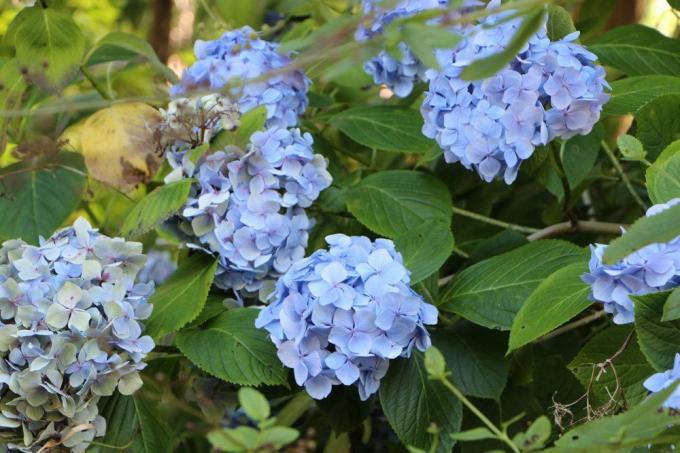
table of contents
- Toxins
- Hydrocyanic acid
- Hydrangine
- Intoxication effect
- For the people
- Toxicity
- For animals
Hydrangeas are upright, deciduous flowering shrubs. Hydrangea plants are very diverse, their flowers can take on a white, as well as a red, blue, pink or yellow color. As an ornamental plant, they can be placed both in the house and in the garden. The rumor that hydrangeas are poisonous persists. Basically: The hydrangea is only slightly toxic. But - parts of the plant, especially the flowers and leaves, contain hydrogen cyanide glycosides and thus harbor certain risks. You can find out how to protect yourself, your children and pets in the following article.
Toxins
Hydrangea toxins
Hydrangea plants contain various toxins, but only in low concentrations. In addition to hydrocyanic acid, hydrangeas contain hydrangin, hydrangenol and saponins. Whether and to what extent certain parts of the plant are poisonous always depends on the type and amount of consumption.
Hydrocyanic acid
The hydrocyanic acid contained in the hydrangea is found in all parts of the plant, not just in the leaves and flowers. Hydrocyanic acid destroys the red blood cells so that oxygen can no longer be transported. However, this is only the case if it is consumed in large quantities. At high doses it can lead to attacks of suffocation and convulsions, in the worst case to unconsciousness or death from heart failure. In general, the concentration is highest in the leaves and flowers. Accidental consumption, however, carries only minor risks, because the content is so low that no dangerous symptoms should generally be expected.

Hydrangine
Hydrangin, hydrangenol and saponins
Hydrangin, hydrangenol and saponins are vegetable toxins which, when consumed in large quantities, can lead to dizziness and anxiety. Sensitive people already react allergic to contact. If there is a contact allergy, hydrangeas should be avoided. The leaves and flower buds of the hydrangea contain a particularly large number of toxins. If you have children, take special care that these parts of the plant are not swallowed. However, since the leaves and flowers taste bitter when chewed, there is little risk that children will eat large, unsafe amounts. However, should it come to inadvertent, excessive consumption, ask your child immediately how he is and contact a doctor if symptoms arise suddenly.
The following symptoms suggest poisoning or an allergic reaction:
- dizziness
- Anxiety
- Circulatory problems
- Shortness of breath
- cramps
Tip: Since hydrangeas are very colorful and pretty to look at, children could of course still get the idea to taste the flowers or leaves. You should therefore always inform your children in advance not to snack on the plant under any circumstances. If your house or garden is home to a large number of hydrangeas, keep an eye on young children in particular.

Intoxication effect
The hydrangea as a drug
For the people
Since the leaves and flowers of the hydrangea are said to have an intoxicating effect, they are dried and smoked by some people. As a result, they serve as a substitute for cannabis, but their psychoactive effects have not been scientifically proven. According to scientific studies, the intoxicating effect can only be attributed to the placebo effect or cell poisoning. The fact is, however, that certain active substances and toxins are released when smoking. As a result, when you smoke hydrangeas, poisoning can actually occur, because the highly toxic hydrogen cyanide dissolves to a large extent when it is burned. Experts recommend not to dare to experiment in this regard, because the hydrogen cyanide concentration can vary from plant to plant and is difficult to control.
Toxicity
How toxic are hydrangeas for animals?
For animals
Hydrangeas are considered to be (weakly) poisonous for horses, dogs, cats, birds, hamsters, rabbits and guinea pigs. The toxins contained in the hydrangea can cause circulatory problems in these animals, but also gastrointestinal complaints. Due to the low concentration, however, serious symptoms of intoxication only occur when consumed in large quantities. Dogs in particular are usually only at low risk. If your dog has eaten the hydrangea, there is usually no risk of serious poisoning. There are no known deaths in dogs from eating hydrangeas. In addition, the rather bitter taste naturally scares off most animals. If one of your pets has nibbled on the plant, it is still advisable to consult a veterinarian as a precaution.
Tip: If you have a dog, please always make sure that you only use branches from non-toxic plants when playing with sticks. Not only hydrangeas but also other ornamental plants contain active substances that could be toxic to your dog. These active ingredients or toxins can dissolve when you gnaw and get into the digestive tract. If in doubt, find out more about the poisoning information center.
Sources:
https://hanfverband.de/nachrichten/blog/alle-jahre-wieder-weniger-hortensien
https://www.botanikus.de/Botanik3/Ordnung/Hortsensie/hortsensie.html

